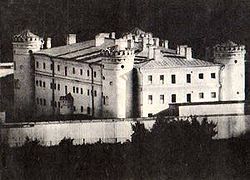Loading AI tools
Castle and prison in Minsk, Belarus From Wikipedia, the free encyclopedia
The Minsk Detention Center No. 1 or SIZO No. 1 (Russian: СИЗО №1, Belarusian: СІЗА №1), informally known as Volodarka,[1] Belarusian pronunciation: Valadarka (Валадарка), is the central prison of the Republic of Belarus located in Minsk.
| Pishchalauski Castle | |
|---|---|
Пішчалаўскі замак (Belarusian) Пищаловский замок (Russian) | |
 | |
 | |
| Alternative names | Pischalauski Castle Piszczalauski castle |
| General information | |
| Location | Valadarskaha Street Minsk, Belarus |
| Coordinates | 53°53′56″N 27°32′52″E |
| Completed | 1824[1] |
| Inaugurated | 1825[1] |
| Design and construction | |
| Architect(s) | Kazimir Khrschonovich[1] |


The prison castle is known in Belarusian as Pishchalauski Castle (Пішчалаўскі замак), also spelled Pischalauski Castle,[2] a name derived from the landlord who built it, Rudolph Pischallo.[1] The Russian version of the name is Pishchalovsky castle.[3]
Its popular name, Volodarka, was coined after the October Revolution, when the street on which the building stood was renamed in honour of revolutionary leader V. Volodarsky.[1] It is also sometimes called the Belarusian Bastille.[2]
Operated by the Belarusian Ministry of Internal Affairs, SIZO No. 1 is the only facility that houses death row inmates. Their execution occurs at the prison.[4] The prison is also used as a pre-trial detention centre where arrested political activists are held.[5]
The stone building was completed by 1824, and it was commissioned in spring 1825.[1] The castle-shaped structure was purposely built as a prison by the landowner Rudolph Pischallo (also spelled Rudolf Pischalo), who entrusted architect Kazimir Khrschonovich (also spelled Casimir Hrschanovicha) with the design.[1][6] The project was approved by Tsar Nicholas I himself.[1] The main building is three stories high, flanked by four corner towers, and surrounded by the prison yard.[1]
After the First World War, the prison was taken over by the Cheka-GPU.[1] Famous Socialist Revolutionary Boris Savinkov, arrested after being lured back to Soviet territory as part of operation "Trust", was held here for a while in 1924.[1]
On the night of 29/30 October 1937, during Stalin's Great Terror, NKVD officers executed 36 representatives of Belarusian culture, science and art in the castle basement, by shooting them in the head. Another 52 were executed that night in the basement of the building of the internal prison of the NKVD in Minsk near the Pishchalovsky castle. In total, during the repressions of 1937-1940, about 100 people were executed in the Pishchalovsky Castle, accused of anti-Soviet activities.[7]
As a result of the Soviet invasion of Poland starting on September 17, 1939, a large number of Polish POWs (military, police, and civil servants) as well as Polish common criminals were imprisoned at Pishchalauski Castle.[1] In 1940-1941, the prisoner was Ryszard Kaczorowski, later the last President of Poland-in-exile.
After the Nazi invasion of the Soviet Union, the Germans kept on using the prison as such.[1]
During the Great Patriotic War, arrested partisans and members of the underground were kept in the Pishchalovsky Castle. Some were executed or tortured there.[citation needed]
In the years 1944-1945 the prisoner was Kazimierz Świątek, later a cardinal of the Roman Catholic Church.
After 1953, it was the only institution in the Byelorussian SSR where death sentences were carried out.[1]
In chronological order of execution:
Pishchalauski Castle is a registered state architectural monument.[8] As of 2013, it was in urgent need of major repairs, with part of one of its four towers having collapsed in April 2008.[1][2] As of 2013, there were speculations that "Volodarka" might be transformed into a museum.[1]
People arrested during and after the 1996 Belarusian referendum and the Minsk Spring and detained in Pishchalauski Castle include:
People arrested during and after the 2020 presidential campaign, which led to the contested reelection of Alexander Lukashenko, and detained in Pishchalauski Castle include:
In chronological order of execution:
Seamless Wikipedia browsing. On steroids.
Every time you click a link to Wikipedia, Wiktionary or Wikiquote in your browser's search results, it will show the modern Wikiwand interface.
Wikiwand extension is a five stars, simple, with minimum permission required to keep your browsing private, safe and transparent.